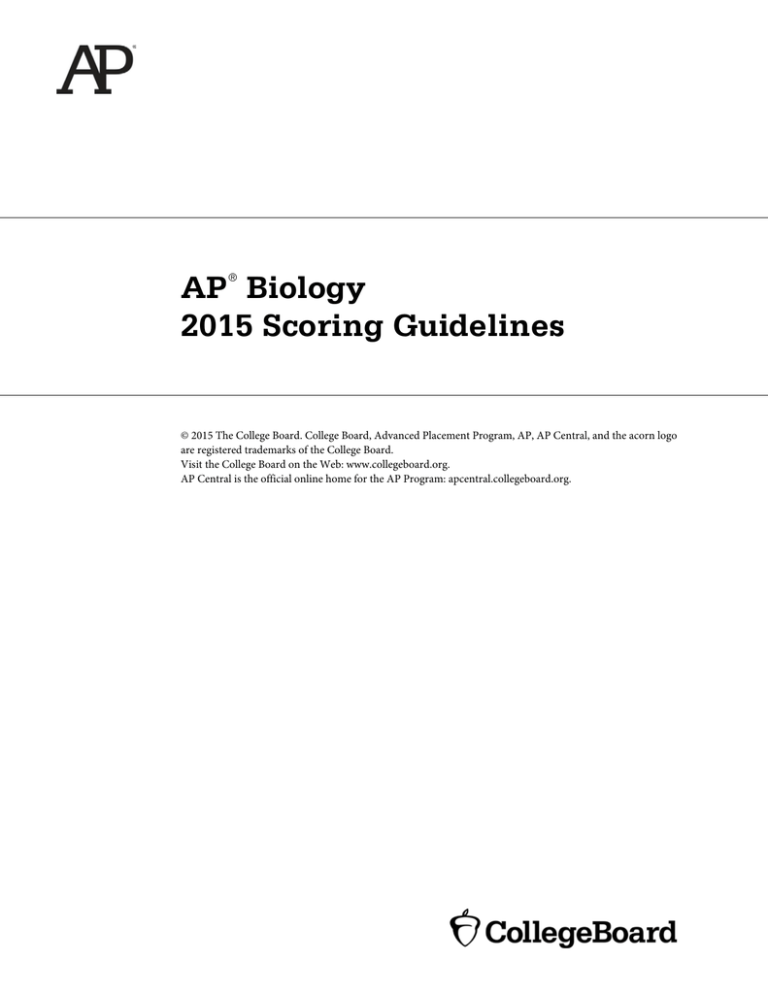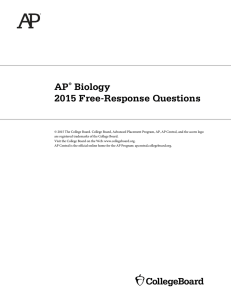AP Biology 2015 Scoring Guidelines
advertisement

AP Biology 2015 Scoring Guidelines ® © 2015 The College Board. College Board, Advanced Placement Program, AP, AP Central, and the acorn logo are registered trademarks of the College Board. Visit the College Board on the Web: www.collegeboard.org. AP Central is the official online home for the AP Program: apcentral.collegeboard.org. AP® BIOLOGY 2015 SCORING GUIDELINES Question 1 Many species have circadian rhythms that exhibit an approximately 24-hour cycle. Circadian rhythms are controlled by both genetics and environmental conditions, including light. Researchers investigated the effect of light on mouse behavior by using a running wheel with a motion sensor to record activity on actograms, as shown in Figure 1. Figure 1. Strategy for recording mouse activity data. When a mouse is active on the running wheel, the activity is recorded as a dark horizontal line on an actogram. When the mouse is inactive, no dark line is recorded. For the investigation, adult male mice were individually housed in cages in a soundproof room at 25°C. Each mouse was provided with adequate food, water, bedding material, and a running wheel. The mice were exposed to daily periods of 12 hours of light (L) and 12 hours of dark (D) (L12:D12) for 14 days, and their activity was continuously monitored. The activity data are shown in Figure 2. © 2015 The College Board. Visit the College Board on the Web: www.collegeboard.org. AP® BIOLOGY 2015 SCORING GUIDELINES Question 1 (continued) Figure 2. Actogram of mouse activity under L12:D12 conditions. Each row represents a 24-hour period, and the dark horizontal lines represent activity on the running wheel. After 14 days in L12:D12, the mice were placed in continuous darkness (DD), and their activity on the running wheel was recorded as before. The activity data under DD conditions are shown in Figure 3. Figure 3. Actogram of mouse activity under DD conditions. Each row represents a 24-hour period, and the dark horizontal lines represent activity on the running wheel. © 2015 The College Board. Visit the College Board on the Web: www.collegeboard.org. AP® BIOLOGY 2015 SCORING GUIDELINES Question 1 (continued) (a) The nervous system plays a role in coordinating the observed activity pattern of the mice in response to light-dark stimuli. Describe ONE role of each of the following anatomical structures in responding to light-dark stimuli. • • • A photoreceptor in the retina of the eye The brain A motor neuron Photoreceptor Brain Motor neuron Descriptions (1 point per box; 3 points maximum) Detects light/dark stimulus and initiates/transmits signal Integrates/processes/coordinates information Transmits signal from brain to an effector (b) Based on an analysis of the data in Figure 2, describe the activity pattern of the mice during the light and dark periods of the L12:D12 cycle. Description (1 point) • Active during dark phase AND inactive during light phase • Active ONLY during the dark period • Inactive ONLY during the light period (c) The researchers claim that the genetically controlled circadian rhythm in the mice does not follow a 24-hour cycle. Describe ONE difference between the daily pattern of activity under L12:D12 conditions (Figure 2) and under DD conditions (Figure 3), and use the data to support the researchers’ claim. Description (1 point) • Active period begins a little earlier each day • Active/inactive period is shorter than 12 hours each day • Daily circadian rhythm is less than 24 hours • Pattern of activity shifts each day Support (1 point) • Without light, active/inactive periods are determined only by the genetically controlled circadian rhythm. • If it were a 24-hour circadian rhythm, the pattern of activity in DD would be the same as the pattern of activity in L12:D12. (d) To investigate the claim that exposure to light overrides the genetically controlled circadian rhythm, the researchers plan to repeat the experiment with mutant mice lacking a gene that controls the circadian rhythm. Predict the observed activity pattern of the mutant mice under L12:D12 conditions and under DD conditions that would support the claim that light overrides the genetically controlled circadian rhythm. © 2015 The College Board. Visit the College Board on the Web: www.collegeboard.org. AP® BIOLOGY 2015 SCORING GUIDELINES Question 1 (continued) Conditions Mutant under L12:D12 Mutant under DD Predicted Activity Pattern (1 point per box; 2 points maximum) Normal rhythm/rhythm similar to wild-type mouse under L12:D12 (Figure 2) • Random activity throughout the 24 hour period • No pattern/rhythm • Constantly active/constantly inactive (e) In nature, mice are potential prey for some predatory birds that hunt during the day. Describe TWO features of a model that represents how the predator-prey relationship between the birds and the mice may have resulted in the evolution of the observed activity pattern of the mice. Selective Advantage Reproductive Success Description (1 point per box; 2 points maximum) • Selection for individuals active at night • Selection against individuals active during the day • Day-active variants susceptible to predation • Night-active variants able to avoid predation • Mice selected for produce more offspring • Mice selected against produce fewer offspring © 2015 The College Board. Visit the College Board on the Web: www.collegeboard.org. AP® BIOLOGY 2015 SCORING GUIDELINES Question 2 Figure 1. Glycolysis and pyruvate oxidation Figure 2. Krebs cycle Figure 3. Electron transport chain Cellular respiration includes the metabolic pathways of glycolysis, the Krebs cycle, and the electron transport chain, as represented in the figures. In cellular respiration, carbohydrates and other metabolites are oxidized, and the resulting energy-transfer reactions support the synthesis of ATP. (a) Using the information above, describe ONE contribution of each of the following in ATP synthesis. • Catabolism of glucose in glycolysis and pyruvate oxidation • Oxidation of intermediates in the Krebs cycle • Formation of a proton gradient by the electron transport chain Description Process (1 point each box; 3 points maximum) Catabolism of glucose in glycolysis and • Produces NADH for use in ETC pyruvate oxidation • Produces acetyl-CoA for entry into Krebs cycle • Provides energy for (substrate level) phosphorylation of ADP Oxidation of intermediates in the Krebs • Produces NADH or FADH2 for use in ETC cycle • Releases high energy electrons for use in ETC • Provides energy to pump protons against their concentration gradient • Produces GTP for (substrate level) phosphorylation of ADP Formation of a proton gradient by the • The flow of protons through membrane-bound ATP electron transport chain synthase generates ATP • Provides energy for (oxidative) phosphorylation of ADP © 2015 The College Board. Visit the College Board on the Web: www.collegeboard.org. AP® BIOLOGY 2015 SCORING GUIDELINES Question 2 (continued) (b) Use each of the following observations to justify the claim that glycolysis first occurred in a common ancestor of all living organisms. • Nearly all existing organisms perform glycolysis. • Glycolysis occurs under anaerobic conditions. • Glycolysis occurs only in the cytosol. Observation Nearly all existing organisms perform glycolysis Glycolysis occurs under anaerobic conditions Glycolysis occurs only in the cytosol Justification (1 point each box; 3 points maximum) • Trait/gene/process originated early and was inherited/passed down/highly conserved • Glycolysis provided a selective advantage that was passed on to descendants Origin of glycolysis pre-dates free atmospheric oxygen/photosynthesis Origin of glycolysis pre-dates cell types with membrane-bound organelles/eukaryotes/endosymbiosis (c) A researcher estimates that, in a certain organism, the complete metabolism of glucose produces 30 molecules of ATP for each molecule of glucose. The energy released from the total oxidation of glucose under standard conditions is 686 kcal/mol. The energy released from the hydrolysis of ATP to ADP and inorganic phosphate under standard conditions is 7.3 kcal/mol. Calculate the amount of energy available from the hydrolysis of 30 moles of ATP. Calculate the efficiency of total ATP production from 1 mole of glucose in the organism. Describe what happens to the excess energy that is released from the metabolism of glucose. Calculation/description (1 point each box; 3 points maximum) Calculate available energy in ATP 219 kcal Calculate efficiency 0.31 - 0.32 or 31 - 32% Describe fate of excess energy Released as heat/increases entropy (d) The enzymes of the Krebs cycle function in the cytosol of bacteria, but among eukaryotes the enzymes function mostly in the mitochondria. Pose a scientific question that connects the subcellular location of the enzymes in the Krebs cycle to the evolution of eukaryotes. Question (1 point) • A valid scientific question related to evolution of eukaryotes (e.g., Since the Krebs cycle occurs in the “cytoplasm” of the mitochondria (matrix), does it suggest that mitochondria were once prokaryotes?) © 2015 The College Board. Visit the College Board on the Web: www.collegeboard.org. AP® BIOLOGY 2015 SCORING GUIDELINES Question 3 The amino-acid sequence of cytochrome c was determined for five different species of vertebrates. The table below shows the number of differences in the sequences between each pair of species. THE NUMBER OF AMINO ACID DIFFERENCES IN CYTOCHROME c AMONG FIVE SPECIES E. ferus D. polylepis G. gallus A. forsteri E. africanus E. ferus 0 D. polylepis 21 11 13 1 0 18 17 20 0 3 10 0 12 G. gallus A. forsteri E. africanus 0 (a) Using the data in the table, create a phylogenetic tree on the template provided to reflect the evolutionary relationships of the organisms. Provide reasoning for the placement on the tree of the species that is least related to the others. Phylogenetic tree (1 point) NOTE: There can be free rotation around the nodes in the tree. D. polylepis A. forsteri G. gallus E. africanus E. ferus Reasoning (1 point) • D. polylepis has the most differences in amino acids (or changes in DNA or proteins as they relate to amino acids). (b) Identify whether morphological data or amino acid sequence data are more likely to accurately represent the true evolutionary relationships among the species, and provide reasoning for your answer. © 2015 The College Board. Visit the College Board on the Web: www.collegeboard.org. AP® BIOLOGY 2015 SCORING GUIDELINES Question 3 (continued) Identification (1 point) • Amino acid/molecular data Reasoning (1 point) • Morphology may be similar (due to convergent evolution/analogous structures) even if there are differences in amino acid/DNA sequences. • Molecular data (e.g. amino acid changes, DNA changes) directly show genetic makeup/ reveal evolution. OR Identification (1 point) • Morphological data Reasoning (1 point) • Similar molecular sequences may result in different morphologies. • An example of species with similar proteins but different morphology (e.g., chimps and humans). © 2015 The College Board. Visit the College Board on the Web: www.collegeboard.org. AP® BIOLOGY 2015 SCORING GUIDELINES Question 4 Both mitosis and meiosis are forms of cell division that produce daughter cells containing genetic information from the parent cell. (a) Describe TWO events that are common to both mitosis and meiosis that ensure the resulting daughter cells inherit the appropriate number of chromosomes. Description (1 point each; 2 points maximum) • Spindle elements (microtubules) form/attach to chromosomes • Chromatin condenses • Alignment of chromosomes across center of cell prior to chromosome separation • Separation of chromatids/centromeres to daughter cells • G2/M checkpoint occurs in both processes • Replication or synthesis of DNA precedes mitosis/meiosis • Cytokinesis separates daughter cells after mitosis/meiosis (b) The genetic composition of daughter cells produced by mitosis differs from that of the daughter cells produced by meiosis. Describe TWO features of the cell division processes that lead to these differences. Feature Description (1 point each row; 2 points maximum) Mitosis Meiosis Number of divisions/ number of resulting cells 1 division/ 2 cells result 2 divisions/ 4 cells result • • • • Ploidy of daughter cells • Same as parent cell Diploid (2n-->2n or n-->n) • Half of parent cell Haploid (4n-->2n; 2n-->n) Chromatids separate Occurs Not in meiosis I/only in meiosis II Crossing over Does not occur Occurs Homologous chromosomes separate/independently assort Does not occur Occurs © 2015 The College Board. Visit the College Board on the Web: www.collegeboard.org. AP® BIOLOGY 2015 SCORING GUIDELINES Question 5 Phototropism in plants is a response in which a plant shoot grows toward a light source. The results of five different experimental treatments from classic investigations of phototropism are shown above. (a) Give support for the claim that the cells located in the tip of the plant shoot detect the light by comparing the results from treatment group I with the results from treatment group II and treatment group III. Support (2 points maximum) • In treatment II the tip is removed and the plant no longer bends toward light. • In treatment III the cap blocks the light to the tip and the plant no longer bends toward light. (b) In treatment groups IV and V, the tips of the plants are removed and placed back onto the shoot on either a permeable or impermeable barrier. Using the results from treatment groups IV and V, describe TWO additional characteristics of the phototropism response. Description (2 points maximum) • Tip produces a substance/signal/hormone (auxin) in response to light causing the plants to bend • Substance must diffuse from the tip causing the plants to bend © 2015 The College Board. Visit the College Board on the Web: www.collegeboard.org. AP® BIOLOGY 2015 SCORING GUIDELINES Question 6 In an attempt to rescue a small isolated population of snakes from decline, a few male snakes from several larger populations of the same species were introduced into the population in 1992. The snakes reproduce sexually, and there are abundant resources in the environment. The figure below shows the results of a study of the snake population, both before and after the introduction of the outside males. In the study, the numbers of captured snakes is an indication of the overall population size. (a) Describe ONE characteristic of the original population that may have led to the population's decline in size between 1989 and 1993. Description (1 point) • • • • Lacked genetic diversity/variation Was an aged/post-reproductive population/not enough young snakes Had unfavorable sex ratio/too few males Possessed a harmful mutation/disease (b) Propose ONE reason that the introduction of the outside males rescued the snake population from decline. Proposal (1 point) • • • • Increased genetic diversity in the population Increased reproductive success Established beneficial sex ratio/sufficient proportion of males for reproduction Introduced resistance to disease that was affecting the original population (c) Describe how the data support the statement that there are abundant resources in the environment. Description (1 point) • • Population can/does grow If resources are limited population would not grow © 2015 The College Board. Visit the College Board on the Web: www.collegeboard.org. AP® BIOLOGY 2015 SCORING GUIDELINES Question 7 Smell perception in mammals involves the interactions of airborne odorant molecules from the environment with receptor proteins on the olfactory neurons in the nasal cavity. The binding of odorant molecules to the receptor proteins triggers action potentials in the olfactory neurons and results in transmission of information to the brain. Mammalian genomes typically have approximately 1,000 functional odorant-receptor genes, each encoding a unique odorant receptor. (a) Describe how the signal is transmitted across the synapse from an olfactory sensory neuron to the interneuron that transmits the information to the brain. Description (1 point) • Neurotransmitters are released from the olfactory neuron and bind to receptors in the postsynaptic neuron. (b) Explain how the expression of a limited number of odorant receptor genes can lead to the perception of thousands of odors. Use the evidence about the number of odorant receptor genes to support your explanation. Explanation and support (2 points maximum: points may be earned from only one row) Molecular CNS Control Genetic Explanation (1 point) • One odorant molecule can be recognized by more than one odorant receptor • One odorant receptor can bind to more than one odorant molecule Signals integrated in the brain Alternate processing/splicing (of premRNA/primary transcript) Support (1 point) Mathematical combinations expand possible odors detected Multiple interactions among neurons in the brain Multiple receptors can be produced from a gene © 2015 The College Board Visit the College Board on the Web: www.collegeboard.org. AP® BIOLOGY 2015 SCORING GUIDELINES Question 8 An individual has lost the ability to activate B-cells and mount a humoral immune response. (a) Propose ONE direct consequence of the loss of B-cell activity on the individual’s humoral immune response to an initial exposure to a bacterial pathogen. Proposal (1 point) • Does not produce antibodies • Does not produce memory B cells (b) Propose ONE direct consequence of the loss of B-cell activity on the speed of the individual’s humoral immune response to a second exposure to the bacterial pathogen. Proposal (1 point) • Does not mount a faster response than the first response • Mounts a second response at the same speed as the first response • Mounts a second response more slowly than would a normal individual (c) Describe ONE characteristic of the individual’s immune response to the bacterial pathogen that is not affected by the loss of B cells. Description (1 point) • Cell-mediated immunity still active • Components of cell mediated immunity (e.g., Natural Killer/ Cytotoxic T cells) still active • Nonspecific immune response remains active • Components of non-specific immunity (e.g., macrophage/ phagocyte, epidermis) still active © 2015 The College Board. Visit the College Board on the Web: www.collegeboard.org.






